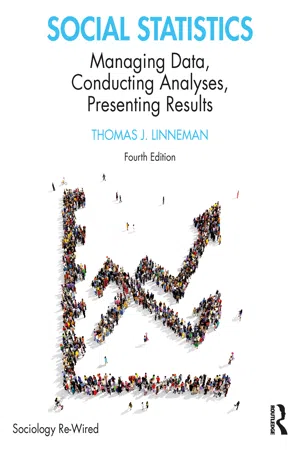
Social Statistics
Managing Data, Conducting Analyses, Presenting Results
- 644 pages
- English
- ePUB (mobile friendly)
- Available on iOS & Android
About this book
With a clear, engaging writing style and fascinating examples using a variety of real data, this text covers the contemporary statistical techniques that students will encounter in the world of social research. It covers these techniques at an introductory level and carefully guides students through increasingly complex examples without intimidating them. Recurrent examples using four timely topics—health, immigration, income inequality, and everyday harassment—help students understand how the techniques fit together, and how to use the techniques in combination with one another. A superb author-created web resource accompanies the text. How to make clear presentations of research results is also a feature of the text.
New to this edition:
- New research shows how the techniques has changed over time in the academic literature, showing students that social scientists really do use the statistical techniques the book teaches and giving them ample motivation to learn the techniques.
- Examples throughout the book use the most recent data from the General Social Survey. Four timely topics are threaded throughout the book: immigration, health, income inequality, and everyday harassment. Linneman uses these topics recurrently with different statistical techniques to illustrate how the techniques are related to one another.
- The new edition more explicitly emphasizes that the various techniques the students are learning are often used in combination with one another. After introducing a new technique and showing how to use it on its own, Linneman then systematically offers examples of how to combine that technique with techniques students learned in previous chapters.
- Most of the literature examples that end each chapter are new and use very recent research from top academic journals (three quarters from 2015 or later, nearly half from 2019). They feature research that covers timely topics such as Black Lives Matter, transgender health, social media, police behavior, and climate change. The SPSS demonstrations are completely redone, both in the book and on the website's demonstration videos, using more recent data. Linneman applies his experience teaching his own students SPSS (knowing where students get confused) to clarify his explanations in these demonstrations.
Frequently asked questions
- Essential is ideal for learners and professionals who enjoy exploring a wide range of subjects. Access the Essential Library with 800,000+ trusted titles and best-sellers across business, personal growth, and the humanities. Includes unlimited reading time and Standard Read Aloud voice.
- Complete: Perfect for advanced learners and researchers needing full, unrestricted access. Unlock 1.4M+ books across hundreds of subjects, including academic and specialized titles. The Complete Plan also includes advanced features like Premium Read Aloud and Research Assistant.
Please note we cannot support devices running on iOS 13 and Android 7 or earlier. Learn more about using the app.
Information
Chapter 1
Life in a Data-Laden Age
Finding and Managing Datasets
- … what data look like in their raw form within a dataset
- … how to work with data to get them ready to analyze
- … the wide variety of datasets that are readily available for analysis
- … how to build an additive index and check if it is acceptable
- … the newer forms that data take, from Internet databases to media analyses
- … types of variables used in statistical analysis
- … a classification of statistical procedures we’ll cover in this book
- … an example of how researchers used the Internet and algorithms to study popular music
- … an example of how researchers used content analysis to study racial stereotyping
Introduction
OG (other guest): What do you do for a living?TL (that’s me): I’m a professor.OG: Really? What do you teach?TL: Introductory sociology.OG: Nice!TL: Social change.OG: Interesting!TL: And statistics.OG: Yikes! I’m sorry. That must be horrible for you.TL: No, I love it.OG: Really? (at this point, OG usually tilts her head to one side and squints a little). Well, I hated my statistics course when I was in school …
Table of contents
- Cover
- Half Title Page
- Series Page
- Title Page
- Copyright Page
- Contents
- Preface to the Fourth Edition
- Acknowledgments
- Chapter 1: Life in a Data-Laden Age: Finding and Managing Datasets
- Chapter 2: The Art of Visual Storytelling: Creating Accurate Tables and Graphs
- Chapter 3: Summarizing Center and Diversity: Basic Descriptive Statistics
- Chapter 4: Using Sample Crosstabs to Talk About Populations: The Chi-Square Test
- Chapter 5: Using a Sample Mean or Proportion to Talk About a Population: Confidence Intervals
- Chapter 6 Using Multiple Sample Means to Talk About Populations: t-Tests and ANOVA
- Chapter 7: Give Me One Good Reason Why: Bivariate Correlation and Regression
- Chapter 8: Using Sample Slopes to Talk About Populations: Inference and Regression
- Chapter 9: It’s All Relative: Dichotomies as Independent Variables in Regression
- Chapter 10: Above and Beyond: The Logic of Controlling and the Power of Nested Regression Models
- Chapter 11: Some Slopes Are Bigger Than Others: Calculating and Interpreting Beta Coefficients
- Chapter 12: Different Slopes for Different Folks: Interaction Effects
- Chapter 13: Explaining Dichotomous Outcomes: Logistic Regression
- Chapter 14 Visualizing Causal Stories: Path Analysis
- Chapter 15 Questioning the Greatness of Straightness: Nonlinear Relationships
- Chapter 16 Problems and Prospects: Regression Diagnostics, Advanced Techniques, and Where to Go Now
- Bibliography
- Index